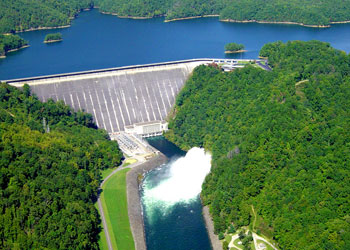
In order to develop atomic weapons during World War II, the Federal Government needed a source of energy to power the top-secret Oak Ridge National Laboratory. Out of that need the Fontana Dam, Fontana Lake, and Fontana Village were born. Located in Graham and Swain counties in western North Carolina, the region is collectively known simply as Fontana. Its history is a fascinating story mixing rural mountain heritage and the progress of modern technology. For more than fifty years, this combination has inspired both precious and painful memories for thousands of people. Breathtakingly spectacular and somewhat bittersweet, Fontana plays an important role in our Appalachian heritage.
fontana dam essay
This essay was based on information provided by Lance Holland’s book Fontana and the websites of Graham County NC, the Fontana Village resort, and WNC Attractions.
The Highest Dam East of the Rockies
Surrounded by extraordinary views of the Smoky Mountains, national forests, and deep river gorges, Fontana is one of the most beautiful dams in the world. Completed in 1944 at a cost of over $70 million, the dam is 480 feet tall and almost
 Fontana Lake
Fontana Lake
The lake created by damming the Little Tennessee River has over 240 miles of rugged shoreline and covers over 11,000 acres. Locals and visitors enjoy boating and other water sports nestled within beautiful mountains. Fontana Lake boasts some of the best pike and bass fishing anywhere. Chambers Creek and Hazel Creek are among many tributaries that feed the lake, offering fishermen an opportunity to catch rainbow and brook trout in their native streams.
The Village
Today, it is difficult to imagine Fontana Village as anything but a beautiful tourist resort. However, for several years in the 1940s, this site was actually North Carolina’s largest city west of Asheville. Because the site was located deep in the Great Smoky Mountains, a railway had to be built to transport supplies. Almost overnight, a community was established in the wilderness. Mountain residents felt both amazement and dismay as their rural environment was transformed before their eyes. Created in order to support
The Road to Nowhere
The birth of Fontana was not without sacrifice and controversy. Almost 70,000 acres of land
directions to fontana
directions to "the road to nowhere"
for more information
- Fontana, A Pocket History of Appalachia by Lance Holland.
- Our Southern Highlanders by Horace Kephart.
- Hazel Creek From Then Til Now by Duane Oliver.
Video:
- Road To Nowhere produced by Jim Bramblet and Robin Briggs


